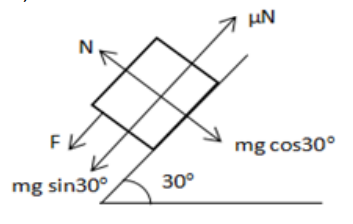A body of mass $2 \mathrm{~kg}$ is lying on a rough inclined plane of inclination $30^{\circ}$. Find the magnitude of the force parallel to the incline needed to make the block move (a) up the incline (b) down the incline. Coefficient of static friction $=0.2$.
a)
Applied force must be greater than net force which is acting downwards to make to move up. $F_{\text {req }}=\mu \mathrm{N}+\mathrm{mg} \sin 30^{\circ}$
$\mathrm{N}=\mathrm{mg} \cos 30^{\circ}$
$M=2 k g, g=9.8 \mathrm{~m} / \mathrm{s}^{2}, \mu=0.2$
On substituting, $F_{\text {req }}=13 \mathrm{~N}$.
b)

Net force acting down the incline is given by
$F_{\text {net }}=2 g \sin 30^{\circ}-\mu \mathrm{N}$
$=2 \times 9.8 \times 1 / 2-(0.2)\left[m g \cos 30^{\circ}\right]$
$=9.8-0.2[2 \times 9.8 \times \sqrt{3 / 2}]$
$=6.41 \mathrm{~N}$
$6.41$ is the force acting down the inclined plane.
This is enough for the body to slide down. No need to exert extra force. So, force required is zero.
